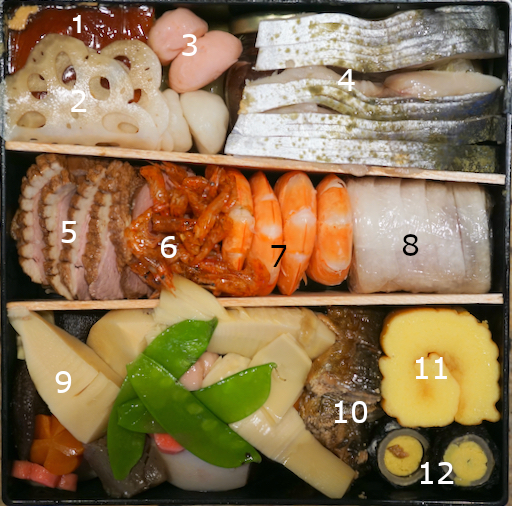
This is a view of the upper box. Black beans (kuro-mame 黒豆) are in the jar (left upper corner) and steamed sea urchin is in the right upper corner. In the center is a small grilled red fish or "Tai" 小鯛の姿焼き and the right to that is beef tongue, Some items are hidden underneath.

This is the lower box. We love "ankimo" monkfish liver terrine (left upper) and this year, we got more of our favorite "karasumi" からすみ or Japanese bottarga (in the upper center). With these two items alone we can consume a lot of sake. The center row includes sake steamed prawns and chestnuts. The 3rd row contains simmered vegetables, duck breast and simmered octopus.

On New Year's Day, I made a plate with the combination of my dishes and the ones from Sushi Taro Osechi. Although, "Datemaki" 伊達巻き (yellow roll) was also in the box, I served the one I made from "Hanpen" はんぺん fish cake and eggs. Besides "matsukaze yaki" 松風焼き (left lower), salmon kelp roll 鮭の昆布巻き (behind Datemaki) and Kazunoko herring roe 数の子 (below Datemaki, the rest of the items are from the box. I added decorative cuts on the red and white fish cake 紅白蒲鉾. A big prawn was sake steamed and delicious.

Daikon Namatsu 大根なます was also included in the box but I served mine with Ikura salmon eggs and sweet vinear marinated octopus.

This is marinated "Russian" salmon with lemon and onion I made as usual from my mother's recipe.

The below are drinking snacks on January 2. These are all from the box. We had this with red wine. From the left, beef tongue, marinated egg yolk with Brasilian nuts (wonderful!), Sweet potato, Datemaki, Chestnut (shibukawa-ni 渋皮煮), Ankimo terrine (right upper), Daifuki mame beans 大福豆 and cherry petal nagaimo. All went well with the wine.

This could have been a lunch on the second. The left is small molded sushi with cured snapper, the front is my salmon kelp roll.

This could have been the 3rd day appetizers. Duck breast, marinated egg yolk, mustard stuffed burdock root, burdock root with sesame sauce, cumquat simmered in syrup, three rolled items on the right (from the top) are cod roe wrapped in kelp, shrimp cake "shinjo" 海老しんじょう wrapped in "yuba" 湯葉 tofu skin, cured snapper with center of vinegared young ginger "gari" wrapped in kelp. All are excellent but the mustard (mixed with egg yolk??) stuffed burdock root is exceptional and only a "pro" could make the items wrapped in the nori sheets (I think).

I have not mentioned all the nice simmered vegetables and several kinds of marinated grilled fish and other goodies. For the past three days of the New Year, we have been indulging in so many small nice dishes. This is better than Christmas feast (at least for me).
This is January 4th. I again combined items from the box with the ones I made. The marinated grilled fish was best served heated up in the toaster oven.

Although this was a lunch, this type of food begs for sake and we succumbed. For starch, we had grilled mochi Izobemaki 磯辺巻き.

I think we have to stop this sometime soon. We are definitely over indulging. The items below were the ultimate snacks for drinking sake including karasumi, ankimo terrine, cod roe wrapped in kelp, sweet fish with its roe and sake steamed prawn.

With these, we finished a bottle of rather dry but very agreeable Suigei 酔鯨 from Kochi 高知.
Again the boxes from Sushi Taro were fabulous. They make a good New Year an even better New Year. We could get used to this life style!
















































